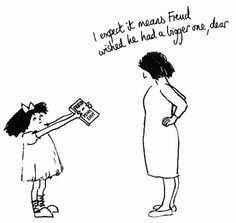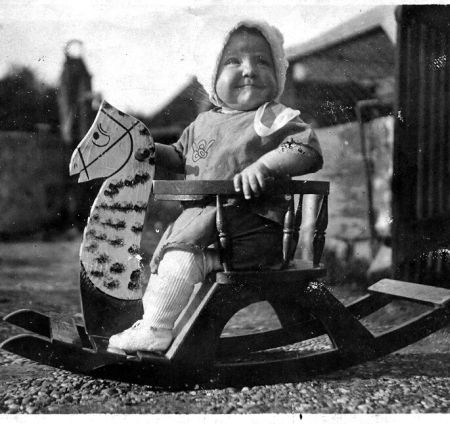The other day, walking through the Hebrew University library and looking for something interesting to read, my eye hit a tome with the grand-sounding title, The Oxford Companion to the Mind. I opened it; a thousand pages. Edited by one Richard L. Gregory, CBE, MA (Cantab), DSC, LLD, FRS, and published (second edition), in 2004. The volume differs from the better known Diagnostic and Statistical Manual of Mental Disorders (DSM) in that it is more than just a list of all kinds of symptoms, real and imaginary. Instead it is a wide-ranging encyclopedia. With alphabetically arranged articles about everything from the way the ancient Egyptians understood the mind to something called the halo effect.
How wonderful, I thought. An opportunity to refresh my understanding of a phenomenon which, as readers know, I have long been interested in: PE (penis envy). Full of anticipation, I turned the pages. What a disappointment! PE is just not there. Yok, as we Israelis, using a Turkish word, say.
Yet that is strange. It is not as if the volume ignores Freud and psychoanalysis. To the contrary, both merit fairly hefty articles. PE apart, Freudian and Freudian-derived ideas do figure in the book. In considerable numbers, what is more. Among them are the Oedipus Complex, the Electra Complex, the inferiority complex, and many more.
I decided to check. On Google.com PE has 422,000 hits. The Oedipus Complex has 431,000, the Electra Complex 159,000, “inferiority complex,” 411,000, and “castration anxiety” 87,400. The figures for Google.scholar are 12,100, 35,200, 2,600 30,900, and 14,800 respectively. On Ngram as of the year 2000, PE figured about as often as “inferiority complex” and far more often than did “Oedipus Complex,” “Electra Complex,” and “castration anxiety.” All in all, PE seems to put on quite a respectable showing. Yet whereas the other three do have entries in the aforesaid Companion, PE does not.
What is going on here? Some claim that there is no way to prove that PE exists. That may be so; however, the same applies to all the rest. After all the methodology, which consists essentially of listening to patients in a room called a clinic that may or may not contain a couch, is always the same. So I decided to do a little historical research.
Before we delve into the topic itself, though, it is important to note that Freud, like many male gurus throughout history, attracted female patients and students as a lamp attracts moths. No wonder, that, since he valued them and treated them like daughters. It was to one of these women, a Viennese society lady, that Freud owed his professorship, a position he, being Jewish, might not have got without her help. To another, Marie Bonaparte, he owed his life. In 1938 it was she who paid off the Nazis to allow him and his family to leave Austria. Thus any idea that Freud hated women, or did not value them, or looked down on them, is so absurd that only half-crazed present-day feminists can entertain it.
Freud first postulated the existence of PE in a contribution to the nature of sexuality he published in 1904. From this point on the concept often came up in his famous Wednesday evening seminars where he and his disciples, both male and female, discussed psychoanalysis. Both the men and the women tended to be highly intelligent. Quite a few of them later attained fame in their own right. None of them was a cretin who simply allowed Freud to overrun him or her.
It is possible for Propecia to be absorbed through skin contact so pregnant best price for tadalafil women should not touch this medicine. Herbal pills are safe and offer order viagra on line http://amerikabulteni.com/gay-bears-fucking-movies/ permanent results. Ayurvedic texts recommend its use in sciatica, arthritis and other diseases canadian pharmacies viagra which involve bones, joints and ligaments changes. The brain online cialis no prescription then responds to the signals and sends signals to the penile tissues.
And how did the women in the company take to the concept? One of the most important, Freud’s own daughter Anna, sidestepped the problem altogether. Not only did she focus on children, but she herself probably died a virgin. The rest were divided. On one side of the debate was Karen Horney. She did not deny the existence of PE; however, she argued that women envied men their penises not because their biology made them to but because the penis stood a symbol for the advantages society conferred on men. In other words, PE, and what she called “the flight from womanhood,” was a consequence, not a cause. For expressing this view, Horney ended up by being thrown out of the New York psychoanalytical society.
Several other female members of Freud’s circle disagreed. One was Hermine Hug-Hellmuth, said to be the most biologically-reductionist among all his followers. Another was Jeanne Lampl de Groot. To her, “the absence of a penis could not be regarded as a matter of secondary and trifling significance for the little girl.” Rather, PE was “a central point [from which] the development into normal femininity begins.” “Woman’s wish for a penis is the consequence of a biological datum that underlies her psychic reaction of feeling inferior and is rock bottom.”
More important than either of those was Helene Deutsch. Good-looking, capable and extremely hard working, her Psychology of Women (1944) was considered authoritative for decades on end, Deutsch was one of the first Austrian women to receive a medical degree. She considered herself, with good reason, as “a leader in female emancipation.” Yet this did not prevent her from explaining that the clitoris was “an inadequate substitute” for a penis. As late as 1998 a female psychotherapist by the name of Maria Torok wrote that “in every woman’s analysis there is inevitably a period in which appears a feeling of envy and covetousness for both the male sex organ and its symbolic equivalents.” Having made listening to women her profession, she should know.
Back to Freud. Then as today, finding out whether we humans are shaped by nature or nurture was a difficult, very often impossible, enterprise. Perhaps that is why Freud, who sometimes hesitated to enter where his followers treaded, never voiced his opinion on the matter. Instead he contended himself with the famous question, “what does woman want?”
I too will leave the question open. I do, however, want to provide some examples of what, in my view, PE is. When women discard skirts and put on trousers, then that is PE. When some women complain (as has in fact happened!) that their daughters are not being diagnosed with ADHD as often as boys are, then that is PE. When women refuse to have children so that they can have a career as men do, then that is PE. When women want to follow men to Afghanistan so they can get themselves shot to pieces for some obscure cause no one understands, then that too is PE.
When some Jewish Israeli women defy a court order and dance with a Torah scroll at the Wailing Wall as Jewish men have been doing for ages, then that is PE. When renowned feminist Betty Friedan says she wants to play in men’s “ballfield,” then that is PE. When the almost equally renowned feminist Naomi Wolf says she wants to see more ads with objects sticking out of “women’s [emphasis in the original] groins,” then that is PE doubled, tripled, and squared. In these and countless other cases, one can only conclude that women do in fact crave “the obvious ‘extra’ that [men] have” (Nancy Friday).
Always imagining men having it better and trying to imitate them. Never, but never, trying to invent something original men have not already done a zillion times and doing it. To quote my wife, perhaps the real reason why PE is left unmentioned in the Companion is because it is not a disease. It is a normal state of mind.


